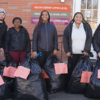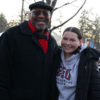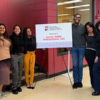ESU’s Relay for Life Team Raises Most Funds Among 33 Competing Teams

Posted by: admin on June 20, 2014, No Comments

CAPTION: Members of ESU’s Residence Life and Housing Department banned together to participate in the 2014 Relay for Life. Their joint efforts raised more than $15,000 of the event’s total ($97,826.18) during last Saturday’s initiative at Eiler-Martin Stadium. ESU team members from left to right are: Patrick Monaghan, resident director, Hemlock Suites; Jeter Smith, resident director, Linden Hall; Matthew Simmons, resident director, Shawnee Hall; Ryan Kassis, resident director, Lenape Hall; Kelly Weaber, resident director, Hawthorne Suites; and Bob Moses, director of residence life and housing. Team members missing from the photo are Quianay Bennett, resident director, Minsi Hall; Kelly Aprahamian, graduate assistant, University Apartments; and Leah Connolly, graduate assistant, Laurel Hall.
Members of East Stroudsburg University’s Residence Life and Housing Department did their part to help the Monroe Unit of the American Cancer Society in exceeding the goal of for their Relay for Life initiative last weekend. The event, held at ESU’s Eiler-Martin Stadium, raised more than $97,800 with 33 local teams participating, the single largest total in the history of the event in Monroe County. The initial goal was to raise $91,000. Last year, the event raised $89,000.
The nine members of ESU’s Residence life team combined to raise and donate $15,543.36 to the cause. Bob Moses, director of residence life and housing, was the overall top individual fund raiser, having raised nearly $9,000. Patrick Monaghan, resident director of Hemlock Suites at ESU, came in third, raising $1,527.
Each year, more than 4 million people in over 20 countries raise funds and awareness for the American Cancer Society to save lives through the Relay For Life movement. Relay For Life teams camp out overnight and take turns walking or running around a track or path at a local high school, park or fairground. Events are up to 24 hours long, and because cancer never sleeps, each team is asked to have at least one participant on the track at all times.
According to the Relay For Life website, in May of 1985, Dr. Gordy Klatt walked and ran for 24 hours around a track in Tacoma, Wash., ultimately raising $27,000 to help the American Cancer Society fight the nation’s biggest health concern. A year later, 340 supporters joined the overnight event. Since those first steps, the Relay For Life movement has grown into a worldwide phenomenon, raising nearly $5 billion to fight cancer.




